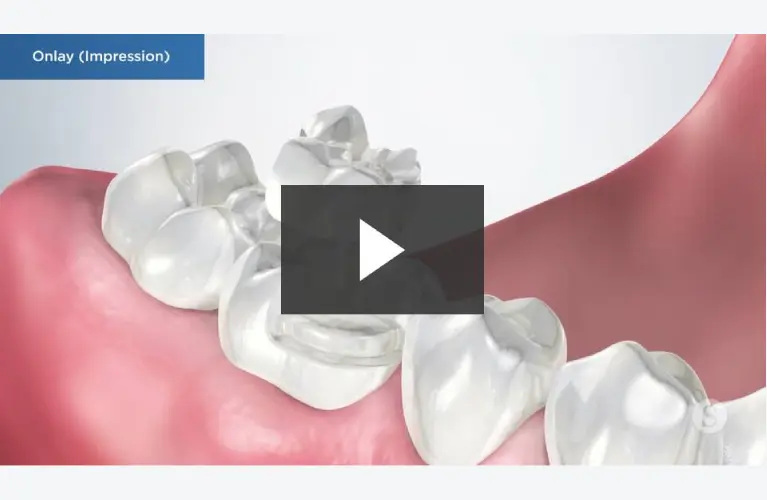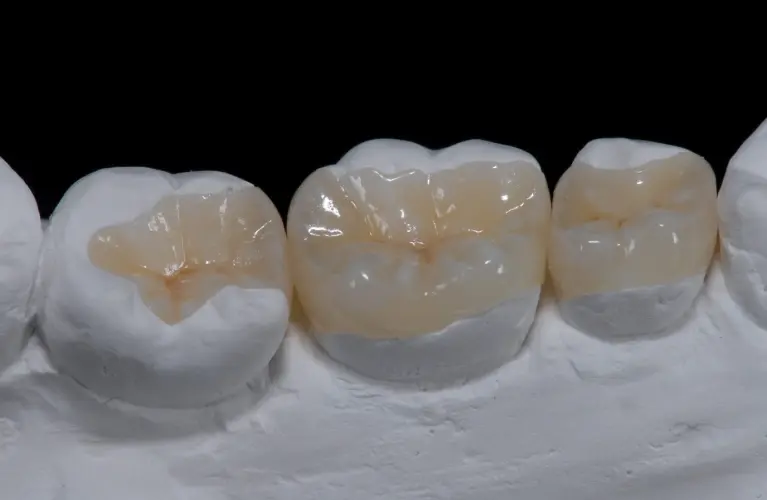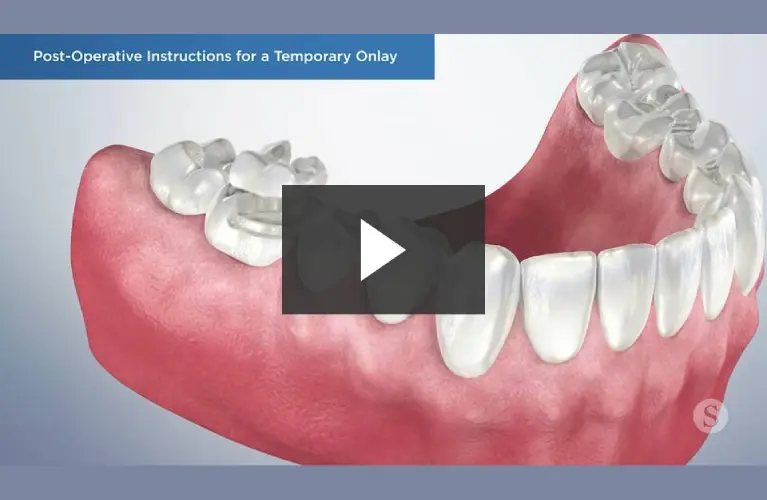
Dental Inlays, Onlays and Overlay - Materials, Procedure & Costs
Unlike traditional tooth restoration, inlays or onlays are made in specialized laboratories in your mouth. These restorations generally use the cavity if it needs repairing the crown’s damaged teeth for the first time.

What are Inlays?
Dental inlays are constructed with solid materials that are customized for your damaged tooth. This fills a hole in your natural teeth causing no further decay, tooth decay, and or injury. Inlays can also be made with gold in various cavities if desired and milled using porcelain depending on the the the cavity shape, size, shape, size and depth. It can be colored in a way that is matching a natural tooth shape.
A dental inlay fits in a tooth groove in a natural tooth structure or cavity. The damaged tooth often is not extended beyond its gums. Often the dental inlay restoration is invisible but durable to the tooth damaged.
Inlays vs. Fillings
A filling is a dental procedure and a simple restoration method for posterior teeth. The dental filling procedure both fills a cavity and stops the decaying tissue from further decay from tooth from further decay.
Fillings are simple to place and are typically completed in the dental office within a few minutes. The Inlay is the same as the Filling.


What is Onlays?
Unlike inlays or other dental treatments or dental crowns, onlays are constructed of a durable material customized for your mouth. The teeth may also have a shape or color matching your natural teeth too. – Onlays are inlays and onlays are much bigger than inlays but smaller than dental crowns. This fills an open cavity that runs through the teeth cusps. Dental onlays are often used for repairs of minor cavities.
These are usually recommended when the cavity is large. But used to put composite fillings in small spaces. The material onlay covers is stronger than the filling as it is made of gold or porcelain. However, this will require more work. This procedure takes the dentist around 2 visits.
What is an overlay in dentistry?
Unlike crowns, they help strengthen damaged teeth by covering the surface of teeth, but they also aim to preserve most of natural teeth and the natural tooth structure their remains.
What is onlay and overlay?
Inlay, Onlay, Overlay. Inlay is similar to fillings, but the entire process is located onlay placement within the cusp (bumps) of the chewable surface. Onlays extend beyond the inlay and can cover a few cusps. Onlays have sometimes been termed partial crowns. Overlay is extended from the onlay.


What are Inlays and Onlays Made of?
Gold
In the past, gold was the material of choice for inlays and onlay because of its strength. Since gold is extremely durable and has similar properties to teeth and cavities, it protects weakened tooth, or damaged tooth, cavities, teeth and cusps extensive damage caused by cavities dental decay and trauma.
Today, with introduction of tooth-colored ceramic restorations, gold dental restorations are less desired.
Gold inlays are typically used if a filling repeatedly fractures. For aesthetic reasons, you may choose a composite material, resin material or ceramic (porcelain) inlays or composite material, composite resin material or resin in fillings over those made of gold. However, they are more prone to damage, since they and other ceramic materials and composite resin materials are more brittle than gold.
Some dentists recommend opting for gold inlays or onlays in small cavities or in areas of the mouth where appearance minor tooth decay is not important further than minor cavities or tooth decay is not minor in larger cavities, such larger cavities such as the back molars.
Advantages
- Very strong and malleable
- Extremely low chance of fracture
- Stain-resistant
Disadvantages
- Does not blend in with your natural tooth color
- More expensive than other restorations
- Tooth-colored, plastic and glass materials called composite resin fillings - Direct Fillings

Ceramic (Porcelain)
Ceramic inlays and onlays can be made of porcelain. Dentists use porcelain to create tooth-colored restorations that mimic the color, shape, and function of natural teeth.
Advantages
- Strong and durable material
- Less prone to fracture than traditional fillings
- Blends in with the color of your natural teeth
- Stain-resistant
Disadvantages
- More fragile than gold restorations
- Despite its strength, ceramic is a rigid material with an increased risk of fracture

Composite Resin
Composite inlays and onlay fillings where small cavities are too large for traditional fillings. They are an alternative to gold or ceramic composite fillings simple filling and restorations and perform a few days the same functions.
Advantages
- Stronger and less prone to fracture than traditional dental fillings
- Tooth-colored (blends in with your natural teeth)
Disadvantages
Weaker than gold or porcelain restorations
- Less malleable than gold restorations
- Not stain-resistant
During an inlay or onlay procedure, you can expect the following steps:
Cavity or dental crown decay or filling removal (if necessary): If there is an existing cavity size the dental crown filling or decay in permanent crown of your tooth, it will be removed to prepare the restored tooth, for the inlay or the permanent crown onlay. The dentist will shape the restored tooth cavity, ensuring it meets specific parameters for easier placement of the restoration.
Impression of the prepared tooth (inlay/onlay mold): In the very first appointment visit, a mold of biting surface of the dental onlay that covers the prepared tooth will be taken. If you choose a ceramic restoration dental inlay or onlay only, you will also select the shade during this visit.

Temporary filling placement: While the inlay or permanent onlay is being fabricated, a temporary filling will be placed before dental inlay or permanent onlay on the same root canal treatment or affected tooth to seal the cavity. This temporary filling helps prevent further tooth decay and protects the root canal treatment affected tooth from sensitivity caused further tooth decay, or by temperature changes.
Inlay/onlay placement: Once the restoration of the tooth is ready, you will schedule another appointment with your dentist for placing the dental inlay, or dental onlay.
During this first appointment only, your dentist may administer a local anesthetic to minimize pain and enhance your comfort during dental procedures. The temporary dental filling will be removed with local anesthetic, and the inlay or permanent dental onlay then will be cemented onto your tooth with local anesthetic.
Nowadays, with advancements in dental technology, porcelain and composite inlays and onlays can be created in-office using CAD/CAM technology and milling machines like CEREC. This quicker process enables the same day same-day placement of the restoration without the need for a full temporary crown or dental filling first. In a quicker process in such cases, you would undergo steps one and two, skip simple temporary crown filling in step three, and proceed directly to permanent crown inlay ceramic inlays and onlays in step four, all within a single visit to dental office.
What are Some Aftercare Tips for Inlays and Onlays?
After getting your dental inlays and onlays and dental onlays done for dental treatments or doing dental inlays and onlays yourself for dental procedures, it’s important to take proper care of them to ensure their longevity and maintain good oral health. Here are some aftercare tips for dental inlays and onlays and dental onlays:
Maintain good oral hygiene: Brush your teeth at least twice a day with a soft-bristled toothbrush and fluoride toothpaste. Floss daily to remove plaque and food particles from between your teeth and around the restoration.
Be gentle while brushing and flossing: Avoid using excessive force or aggressive brushing techniques around the inlay or onlay. Gentle brushing and flossing will help prevent damage to the restoration.
Avoid biting surface chewing on hard objects: Refrain from biting surface chewing on hard objects such ceramic materials such as ice, pens, or fingernails, as this can put unnecessary stress on the inlay or onlay and increase the risk of damage.
Watch your diet: Limit your consumption of sticky or hard foods that can potentially dislodge or damage the restoration. Additionally, reduce your intake of sugary and acidic foods and beverages to minimize the risk of tooth decay and damage to the surrounding tooth structure.
Visit your dentist regularly: Maintain regular dental check-ups and professional cleanings. Your dentist will monitor the condition of the dental inlay or onlay and ensure that it remains in good shape. They can also address any issues or concerns you may have.
Report any discomfort or issues: If you experience any discomfort, or sensitivity, or notice any changes in the fit or integrity of the tooth inlay or tooth onlay, contact your dentist promptly. Early intervention can help prevent further complications.
Remember, proper care and maintenance of dental crowns, will contribute to the longevity and effectiveness of your dental crown full and partial dental crowns and your tooth inlays or onlays. Follow these dental crown aftercare tips and consult with your dentist if you have any questions or concerns about dental crown,.
The Pros and Cons of Inlays and Onlays

Here are the benefits and drawbacks of availing of either an inlay or an onlay for your posterior teeth that have cavities or dental caries in them.
PROS of Inlays
- An inlay is much smaller than a crown denture.
- It’s placed on bigger cavities running deep into the tooth’s crown and dentin.
- They’re better than fillings at filling in deep cavities.
Cons of Inlay
- An onlay covers more wide space than an inlay but choosing between either depends on cavity shape anyway.
- A crown tends to cover the whole tooth, thus protecting it more.
Pros of Onlays
- An onlay is even bigger than the inlay, ensuring better coverage.
- It covers most of the crown but not the totality of the tooth.
- You can use it to cover the cavity that has eaten up most of the tooth’s crown.
Cons of Onlay
- An inlay is more of a perfect fit for deep cavities that haven’t reached the tooth root.
- It also only covers the top part of the tooth so a crown has superior coverage compared to it as well.
FAQ
What is crown and onlay?
Crowns cover the entire bite surface of teeth including a dental arch over a gumline. Contrary to crowns, dental procedure for an onlay is an occasional small restoration if possible because less teeth are removed. It’s comparatively cheaper to have onlays than crowns if the dentist or they dentist have more.
What is the difference between crown and onlay?
The significant differentiation of onlays inlays between the two is that while onlays cover tooth cuspas, inlays are merely filled with parts of them. The crown of onlays inlays covers all biting parts of the tooth including the structure of the teeth beneath its gumline.
What is difference between inlay and onlay?
Onlays cover the cusp and the inlays cover only a few days the surface in between these cusps. In contrast, a crown covers a portion of the gumline and teeth below the gum line. Both have similar costs, though Onlay may be cheaper.
What is the purpose of dental onlay?
Dental onlays are restoration procedures commonly used for treating damaged or decayed tooth or teeth. Inlays offer powerful and longlasting treatment solutions to tooth and dental decay too.
What is the difference between onlay and veneer?
These two restoration products match the teeth of the patient.. A veneer is a tooth-like shell anchored to a tooth and onlays are partial crowns inserted to protect severely-damaged teeth.
What is onlay and overlay?
Inlay, Onlay, Overlay. Inlay is similar to fillings, but the entire process is located within the cusp (bumps) of the chewable surface. Onlays extend beyond the inlay and can cover a few cusps. Onlays have sometimes been termed partial crowns. Overlay is simple filling that is extended from the onlay.

